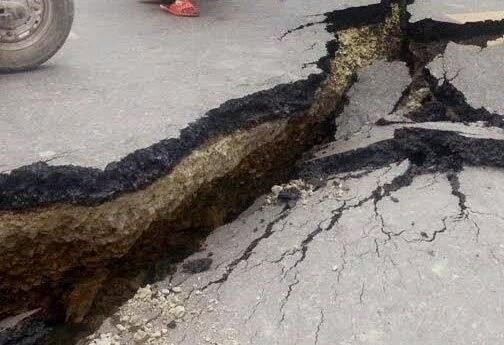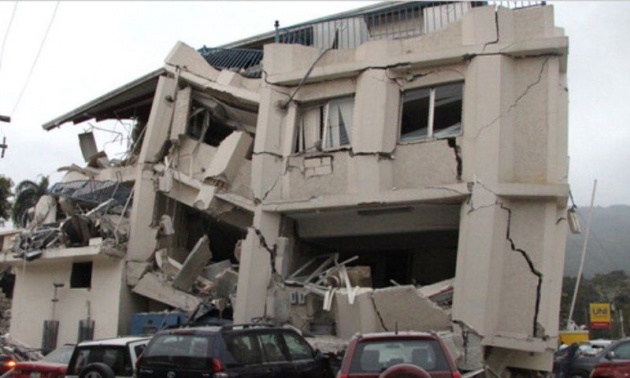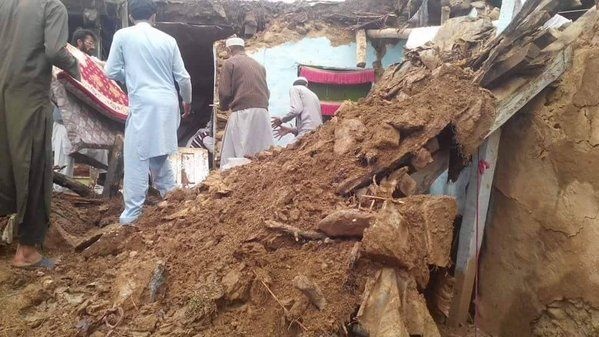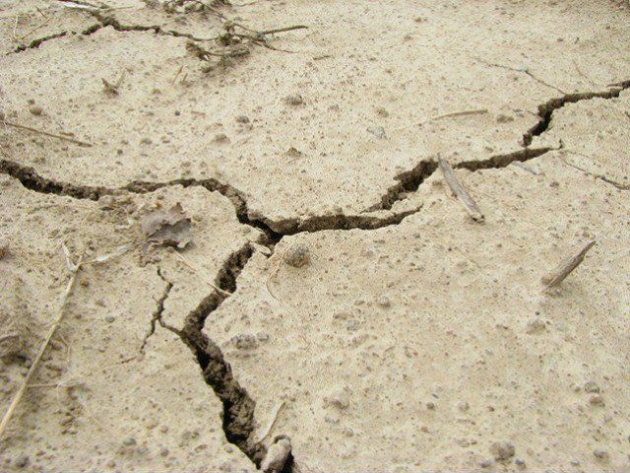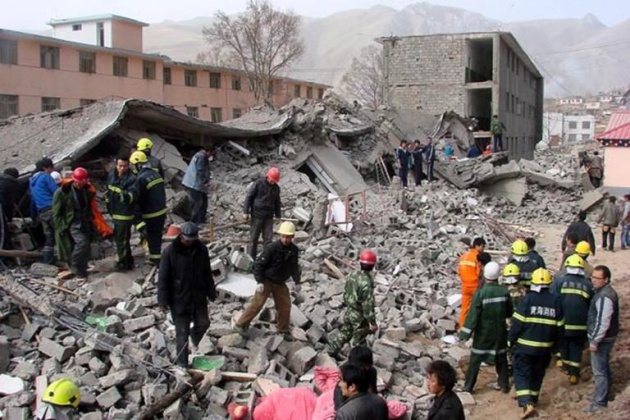Earthquakes: Facts

When the surface of the earth moves in response to heat and pressure from below, the shaking is called anearthquake. Earthquakes are a very common occurrence. Once every 30 seconds somewhere in the world the ground shakes. The estimates are that there are about 500,000 detectable earthquakes a year, 100,000 of those can be felt, and about 100 of them cause damage. Scientists and kids alike are fascinated by the shaking of the ground. To find out how this shaking happens, we need to see what is going on under the ground.
Inside the Earth
Let's begin by looking at the structure of the earth. Earth is made of rock that is very thick. It's divided into 3 main sections: crust, mantle, and the core. This animation from WNET will show you these layers.

Huge sections of the crust, called tectonic plates, are always moving; some floating like huge rafts on the almost-liquid rocks below! When this happens, under great pressure and heat, the rock in some places becomes squeezed, stretched, or folded and can break. Sometimes they even crash into one another. The location where these plates meet or come together is known as a fault.
The squeezing and folding can stretch the rocks or push them together. Rocks can also break under this stress and release huge amounts of energy in the form of shock waves. Some shock waves move through the ground before a volcano erupts, or underground where new crust is being formed. Most occur at tectonic plate margins as one plate moves under another or where plates are sliding past each other. It is very hard to imagine rocks bending and folding or even large areas of land sliding under layers of the ground. But this truly does happen and has been since the earth began.
Where Do Earthquakes Happen?

Earthquakes can happen in many places, but there are some areas where they are concentrated. They occur at or close to the edges of the major tectonic plates. One of these areas along the Pacific Ocean is called theRing of Fire. The epicenter of an earthquake is the place on the Earth's surface directly above the focus (more than one are called foci), which is the place inside the Earth where the quake originates. Foci are usually somewhere between the surface and 100 km in depth. Find out where the latest earthquakes have been in the United States and in the world.
Waves
Earthquakes travel in ripples or waves across the earth and through the layers of the earth. If a person were standing in just the right location and could see the surface of the earth during an earthquake, the ground would actually appear to be moving in a wave. These waves travel in two types.
P waves — or primary waves because they travel faster — will be felt first.

S waves — or secondary waves — are usually 2 – 3 times larger than the P wave. This leads to the characteristic shape of an earthquake on a seismogramwith a small P wave followed by a larger S wave. Because the P wave is traveling faster, the time between the P and S wave increases away from the earthquake. As the waves move, they can actually collide into one another and reverse direction, causing additional damage. See an animation of the P wave here to get a good view of wave movement.
Measuring Earthquakes
Seismology is the study of earthquakes and a seismologist is the scientist that studies earthquakes. A seismograph is an instrument used to measure earthquake shocks. It records the data using a special pen and paper rolled on a moving cylinder. As an earthquake is recorded, the pen jumps back and forth on the paper showing theintensity of the earthquake. It can record tiny earth tremorsthousands of miles away. Hundreds of seismograph stations are located all over the world. Seismographs can be used to find an earthquake's epicenter and its focus underground. They record "P" waves and "S" waves.

Geologists and seismologists use two different scales to measure how strong an earthquake is. The Richter Scale measures magnitude, the amount of energy released by an earthquake by measuring how big a shock wave is. Each number on the scale is 10 times more powerful than the number below it. A magnitude 3 earthquake is ten times greater that a magnitude 2 and is easily felt. An earthquake that registers 6 or more is considered a major quake. Learn more about the Richter Scale here.
In addition to the Richter scale, scientists also use the Mercalli Intensity Scale to measure the amount and type of damage caused by the earthquake. Usually the intensity is greater near the center of the quake. Learn more about seismographs.
Early Explanations

Humans developed many explanations for earthquakes before they had the understanding and instruments to study them scientifically. You can read about some of these ideas about Earthquake Myths and Folklore.
Here's a myth from Mongolia, China. A gigantic frog which carried the world on its back, twitched periodically, producing earthquakes.
Moonquakes

Did you know that there are earthquakes on the moon? They're called "Moonquakes." Get more information on Moonquakes fromNASA.
Earthquake Dangers

The energy of an earthquake can be felt for many miles. The shockwaves can travel through the surface of the earth but they can also travel through the layers of the earth where they bounce off of matter inside the earth. Even following an earthquake,aftershocks can repeat over and over for days or months. An aftershock is a smaller quake which follows the original one, but can still continue to cause additional damage to an already troubled area of land. They usually decrease in size and frequency with time.
Earthquake shaking can cause much destruction and loss of life. The ground under buildings can become loose and buildings can fall or sink. Rockslides can occur. Liquefaction, ground displacement, flooding, tsunamis, and fire are all hazards of earthquakes. Learn more about earthquake hazards here.

from WNET and PBS ‐ "Savage Earth"
One of the greatest dangers is a tsunami. A tsunami happens when shocks from the earthquake create huge waves that come inland and strike communities along the ocean coast. In the ocean tsunamis may be only 1m (3 ft) high and can be 90 miles apart. They can travel at 500 mph. When they reach shallow coastal waters they can grow to 35m (115 ft) high and cause massive flooding!
Predicting Earthquakes

No one can predict earthquakes yet, nor prevent them, but you can protect yourself bypreparing for one. One way scientists help is by comparing readings from widely spaced seismographic stations to determine the exact position of the earthquake's origin. This can help to warn of tsunami in the Pacific Ocean.
Earthquakes in Idaho

The United States Geological Survey provides a history of earthquakes in Idaho. Did you know that Idaho ranks fifth in the nation for earthquake hazard, behind California, Nevada, Utah, and Alaska? The two largest earthquakes in the lower 48 states in the last 45 years have been in Idaho (1959 and 1983). Both caused fatalities and damage.
Photos of the aftermath of the 1983 Borah Peak Earthquake near Challis, Idaho
